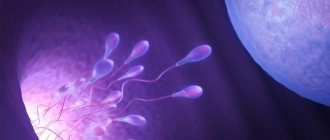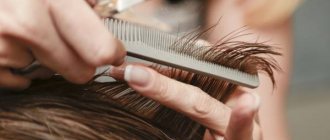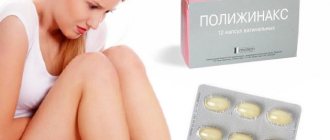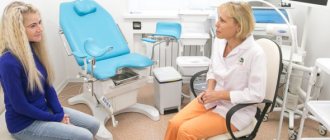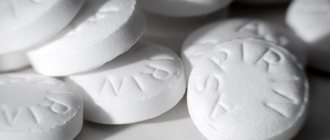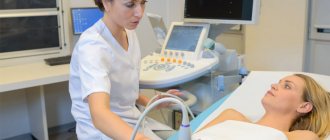Women often wonder when faced with this topic: is it possible to do electrophoresis during menstruation?
Let's first understand what electrophoresis is. This is a type of physiotherapy in which drugs are introduced into the body using current through the skin or mucous membranes. Pads are placed under the electrodes, which are soaked in the medicine, and a small current is applied. It is used in completely different branches of medicine.
This procedure is simple, painless and completely safe; it can be performed even by pregnant women in the absence of contraindications, and, of course, under the supervision of a doctor. It has a double benefit, since in addition to the administered medication, the weak current has a beneficial effect on the skin.
Basic physical principles of the method’s influence on women’s health
Therapeutic electrophoresis is based on the physical principle of influencing the affected organs and tissues with small amounts of direct current. Electric particles have a positive effect on cell function, enhance metabolic processes in tissues, and promote regeneration.
In addition to the direct effect on the body, electrical particles facilitate the penetration of a wide variety of medications into the cells of organs and systems. This introduction of medicinal ingredients is considered the safest, although it is inferior in effectiveness to traditional injections or tablets. For example, electrophoresis with lidase (it can be done during menstruation) can help set the body up for conception.
Medicines enter through the skin glands and interstitial space in the form of positively or negatively charged particles. The drug accumulates in the subcutaneous fat and, within 2–3 days, is distributed throughout the woman’s body along with the blood.
Since the absorption of the medicinal product is prolonged, from 5% to 20% of the administered substance directly affects the body. Taking into account this feature, it is proposed to increase the amount of medicine on the cloth pads of the electrophoresis apparatus.
Another way to enhance the effect of this technique is to apply electrodes, if possible, directly to the affected area of the body or diseased organ. Thanks to the accumulation effect, it is possible to increase the maximum permissible dose of the drug without harmful consequences for the patient’s health.
One more positive side of this method of physiotherapy should be noted. If medications are delivered to tissues using electrodes, they, unlike tablets and capsules, do not enter the gastrointestinal tract, which significantly reduces the risk of developing allergic reactions and problems with the stomach and intestines.
How does electrophoresis work?
Is it possible to do physical therapy during menstruation?
We are used to physiotherapy being used to treat colds and joint diseases. But it is difficult to overestimate the role of physiotherapy in the treatment of gynecological diseases, when it is not only an auxiliary, but in some cases the main method of treatment.
Moreover, for some diseases, physiotherapy is the only treatment. We are talking about chronic pelvic pain due to adhesions or neuralgia of the pelvic nerves, when medications cannot help at all.
Physiotherapy significantly shortens the postoperative period, prevents the formation of adhesions, restores damage to the uterine mucosa, and also solves the problem of poor blood circulation, which cannot always be done with medications.
In addition, physiotherapy has no side effects, and its use in the treatment process allows you to reduce or completely eliminate the use of medications. But it should be remembered that physiotherapy is prescribed by the attending physician and strictly individually.
• magnetic therapy, which has an anti-inflammatory effect;
• electrotherapy: electrophoresis, electrical stimulation, etc. Thus, treatment with pulsed currents relieves spasms of blood vessels and smooth muscles, and this helps improve blood supply to tissues and has an analgesic effect;
• ultrasound therapy, which creates an analgesic effect, “softening of adhesions”, and also helps to improve blood supply to tissues and increase the hormonal activity of the ovaries;
• phototherapy and light therapy – methods that use UV and infrared rays that have a bactericidal effect;
• laser therapy.
Advantages of electrophoresis
There are many advantages to this type of therapy:
- Medicines are administered in small doses, which greatly reduces the risk of side effects.
- The medicine injected under the skin with electrodes is distributed throughout the body with physiological fluids, because of this the therapeutic effect increases over time.
- Medicine enters the body in the form of ions, and this is the most active form of the substance.
- The drug administered during physiotherapy accumulates in a certain place, without overloading the blood and stomach with concentration.
- The medicine penetrates into the affected areas, even if the blood microcirculation at the site of inflammation is impaired.
- The drug is not destroyed by saliva and gastric juices.
- Electric current charges have a positive effect on the entire body.
Is physiotherapy prescribed during pregnancy?
The list of diseases for which physiotherapeutic treatment is prescribed is large.
• subacute and chronic diseases of the pelvic organs (chronic inflammation of the uterine appendages);
• infertility due to obstruction of the fallopian tubes;
• rehabilitation after operations to restore the patency of the fallopian tubes, after an artificial abortion, spontaneous miscarriage or curettage of the uterine cavity;
• preparation for pregnancy of women who have had spontaneous miscarriages and missed pregnancies;
• preparation of the uterine mucosa before the IVF program (physiotherapy increases the effectiveness of IVF).
Just during pregnancy, when the use of medications is often contraindicated, physiotherapy for the treatment of diseases comes to the fore, as it gives a positive effect with minimal adverse effects on the fetus.
Physiotherapy will help expectant mothers with early toxicosis, with the threat of miscarriage (with the help of physiotherapy they reduce the tone of the uterus), etc.
Physiotherapy is also indicated after childbirth - thanks to it, sutures heal faster after a cesarean section or in case of ruptures. Physiotherapy is used to treat cracked nipples and to prevent mastitis. Physiotherapeutic methods help well with lactostasis, facilitating the release of milk. And darsonvalization is an excellent remedy for the treatment of postpartum hemorrhoids.
Physiotherapy and menstruation: to do or not to do?
But there are also some restrictions. Several times a month you cannot influence the pelvic area; it is best to refuse, on the advice of doctors, any thermal procedures, primarily vaginal sensors and electrodes.
Physiotherapy helps well with the chronic form of endometritis, if combined with the right medications, it can stop the torment altogether. To restore the thin endometrium and restore hormonal balance, procedures such as:
- UHF;
- electrophoresis with potassium iodide and calcium chloride;
- laser;
- magnetic therapy to avoid the appearance of adhesions.
Such physical therapy can be done during menstruation, unless endometritis is accompanied by heavy discharge, but it is worth remembering that it can increase pain.
Other types of physical therapy
Laser therapy is the effect of laser light on a specific area of the body and is used in a variety of branches of medicine:
- in neurology;
- in pulmonology;
- in dermatology;
- in cardiology;
- in otolaryngology;
- in dentistry;
- in gynecology.
During menstruation, laser therapy should not be performed only in case of heavy bleeding.
Most often, doctors do not want to carry out procedures during menstruation due to the fact that pain and complaints from the patient may increase, but this does not pose any danger to the body. But if you are still afraid to carry out treatment during menstruation, then it would be better to start treatment on the 5th or 7th day of the cycle, then the course of therapy will end by the beginning of the next menstruation.
If for some reason there is a break in treatment and lasts more than 3 days, then further procedures will not have any effect on the body, then it would be better to stop the procedures and start the procedures again after 2 months.
Amplipulse therapy
Physiotherapy for men and children
Most people talk about women and gynecological problems, but what about the stronger sex? Electrophoresis is also used for prostatitis. The most effective types are galvanization and medicinal electrophoresis.
Electrophoresis can be performed even on infants. And it’s not scary or painful at all; on the contrary, it’s very useful. The medicine immediately goes to the desired organ, and you can do without painful injections and complications after taking pills.
Children scream or even cry during the procedure, which frightens mothers very much, but this is only because the kids are afraid of an unfamiliar device. The most unpleasant sensations for a child may be cold plates of the device, cold wipes with medicine, or a slight tingling sensation from touching the electrodes, but no more. This procedure is safe even for the smallest child.
Purpose of the treatment procedure
This physiotherapeutic technique has been used in the treatment of various diseases for more than 100 years, so specialists have accumulated extensive experience in its implementation. First of all, electrophoresis is good for various inflammatory processes.
The direct current method perfectly copes with local and general inflammation of tissues, reduces swelling and, accordingly, reduces the severity of pain. This occurs due to increased metabolic processes in the cells of the affected areas and stabilization of the blood vessels in these places.
Electrophoresis perfectly helps with various neurological pathologies, relieving muscle spasms, enhancing microcirculation processes at the cellular level. For various injuries accompanied by tissue damage, this method of treatment can accelerate regeneration processes by more than 50%.
When a patient has a question about whether electrophoresis can be done during menstruation, the specialist must explain to the woman all the positive aspects of this procedure and its effect on the hormonal support of the female body during this period.
How is the procedure performed?
The mechanism of therapeutic electrophoresis is quite simple. If certain rules are followed, the specialist will be able to achieve the desired result in a minimum number of sessions, and without any discomfort on the part of the patient.
Apparatus for electrophoresis
There are several ways to introduce medicinal substances into a woman’s body using electric current. Here are some of them:
- The “bath” procedure involves immersing the diseased part of the body in a special medical vessel with electrodes and a healing solution. The direct current supplied to the electrodes promotes rapid absorption of the medicine into the patient’s arm or leg.
- A good effect can be obtained by using the interstitial method of treatment. The drug is administered into the patient’s body in the traditional way, and special electric attachments are placed on the skin of the problem area of the body. An electric current attracts the medication to the desired location.
- The main technique is galvanic electrophoresis. In this case, cloth pads soaked in a medicinal solution are applied to the patient’s skin. Using electrodes, a special electric field is created, which enhances the absorption of medicinal substances in a certain place and creates a concentration of the drug throughout the thickness of the tissue.
When people wonder whether electrophoresis is done during menstruation, they usually mean the cavity method of this manipulation. Its essence is that one electrode with drug solutions is applied to the patient’s body surface, and the second is inserted into various cavities, for example, into the rectum or vagina.
Of course, if a woman begins to have monthly bleeding, there is no need to talk about any medical procedures of this nature. In addition, any effects on the pelvic organs to reduce menstrual pain syndrome are contraindicated.
Watch the video about the procedure:
Other types of physical therapy
Laser therapy is the effect of laser light on a specific area of the body and is used in a variety of branches of medicine:
- in neurology;
- in pulmonology;
- in dermatology;
- in cardiology;
- in otolaryngology;
- in dentistry;
- in gynecology.
During menstruation, laser therapy should not be performed only in case of heavy bleeding.
Most often, doctors do not want to carry out procedures during menstruation due to the fact that pain and complaints from the patient may increase, but this does not pose any danger to the body. But if you are still afraid to carry out treatment during menstruation, then it would be better to start treatment on the 5th or 7th day of the cycle, then the course of therapy will end by the beginning of the next menstruation.
If for some reason there is a break in treatment and lasts more than 3 days, then further procedures will not have any effect on the body, then it would be better to stop the procedures and start the procedures again after 2 months.
Amplipulse therapy
Contraindications for a therapeutic electrophoresis session
The popularity of this method of auxiliary therapy lies in its complete safety and absence of complications. The very effect of direct electric current on a woman’s body is so minimal that it does not bring any unpleasant sensations to the ladies.
After conducting a number of studies, it was noted that if the procedure is recommended for patients with inflammatory processes, then after several sessions, tissue swelling, hyperemia and soreness may be observed at the site of application of the electrodes. Such manifestations are explained by the reaction of this part of the sick woman’s body to the treatment.
However, the medical literature describes cases of an allergic reaction to injected drugs. In such situations, women may experience redness of the skin, itching and burning at the site where the electrodes are applied.
To relieve such complications, it is enough to administer ampoule solutions of “Diphenhydramine”, “Suprastin” or hormonal drugs. Physiotherapy sessions can be continued no earlier than after 2 - 3 weeks.
As for contraindications for the use of electrophoresis, they are described quite clearly in modern medical literature. These include:
- Various chronic heart diseases, aggravated by heart failure and rhythm disturbances.
- Chronic lung diseases associated with decreased oxygen absorption in the alveoli. Electrophoresis is not recommended for bronchial asthma, tuberculosis, and chronic space-occupying processes in the lungs.
- Any oncological processes, regardless of stage, are also a contraindication for the use of physiotherapeutic methods of treatment.
- Electrophoresis is not recommended for patients with problems with hematopoiesis. Excessive blood clotting or bleeding is equally dangerous when drugs are administered through the skin using an electric current.
In addition to the above, you should not carry out such treatment sessions if patients have various skin diseases or there are damage to the skin at the site of contact of the body with the electrodes. The literature even indicates such an original reason for refusing electrophoresis as a woman’s intolerance to electric current.
Physiotherapy during menstruation
Electrophoresis is a type of physiotherapy that allows medications to be introduced into the body using electric current through the skin or mucous membranes. It is used in various fields of medicine, such as traumatology, ENT, therapy, dentistry, gynecology and others.
This is a fairly simple, painless and safe procedure, which, in the absence of contraindications and under the supervision of a doctor, can be used even during pregnancy. The therapeutic effect is achieved not only through the administration of drugs, but the local effect of a weak electric current on the body tissues improves their condition.
Advantages of electrophoresis over other treatment methods
- the drug is administered in a small amount, which reduces the likelihood of adverse side effects;
- the injected substance accumulates in the tissues at the sites where the electrodes are applied, creating a so-called depot, from which it is then distributed throughout the body with physiological fluids, creating a long-term therapeutic effect;
- ions, in the form of which the medicine penetrates the body, are the most active chemical form of the substance;
- the local form of administration of the drug allows you to create a high concentration in a certain place without increasing its amount in the blood or digestive tract;
- penetration of medicinal substances directly into inflammation is possible even if microcirculation in the surrounding tissues is disrupted;
- there is no destruction of drugs under the influence of saliva and gastric juice;
- Electric current used to administer drugs has a beneficial effect on the body.
Contraindications to the procedure
Despite the many positive aspects and relative safety of electrophoresis, there are also contraindications to its use. These primarily include:
- malignant tumors, regardless of their location;
- some heart diseases;
- acute inflammation;
- heat;
- some skin diseases, such as dermatitis or eczema;
- skin damage at the sites where the electrodes are applied;
- individual allergic reactions to exposure to drugs or electric current.
In addition, physiotherapy can be used with caution during pregnancy. Most often during this period, treatment with papaverine or magnesium is used. At the same time, electrophoresis allows you to use even potent drugs, for example, aminophylline, which is usually used in extreme cases, without harm to the child.
Treatment during menstruation in women
Many doctors tend to refuse to perform procedures during menstruation, although this condition is not an absolute contraindication for electrophoresis.
Bleeding, which is normal during menstruation, is not caused by an acute or purulent disease.
When the treatment does not directly affect the areas of the uterus or ovaries, there is no contact of the electrodes with damaged mucous membranes.
If the procedure is carried out through the skin, then the penetration of active substances into the tissue occurs to a depth of no more than one centimeter. Which should not cause increased bleeding or pain in a healthy body.
Another thing is that during physical therapy, unpleasant sensations caused by a physiological state or some pathologies in a woman’s body may intensify. Therefore, doctors do not prescribe physical therapy during menstruation when it comes to treating gynecological diseases, especially the ovaries.
In other cases, the decision is made jointly by the physiotherapist and the gynecologist, taking into account the individual reactions of the patient
. After all, a break of more than three days in a cycle of procedures is critical and can negate the result already achieved.
Electrophoresis in gynecology
In gynecology, various types of physiotherapy, in particular electrophoresis, are used both to treat inflammatory diseases and to relieve certain pain syndromes, such as algomenorrhea (painful periods) or adhesions in the pelvis.
Various substances are used for exposure, such as iodine, magnesium, papaverine, aminophylline and some others, which are administered both through the skin and through the mucous membranes, depending on the diagnosis
Painful periods are usually expressed in the appearance of aching pain in the lower abdomen, which occurs one or two days before the start of menstruation and goes away on its own after some time.
The reasons can be different, both purely psychological and related to inflammatory diseases of the ovaries or other appendages.
But in any case, the appearance of pain is associated with contraction of the uterus and spasm of blood vessels.
Drug treatment depends on diagnostic results, which reveal the true cause of the pain.
But physiotherapeutic procedures are aimed precisely at relieving pain and spasms. For this purpose, electrophoresis is prescribed on the lower abdomen with novocaine. As a rule, 6-8 sessions are carried out.
They are prescribed in such a way as to complete the procedures by the beginning of the cycle.
The most common diseases of the female reproductive system are various inflammations, which are most often caused by hypothermia or infection through the vagina. In any case, an acute inflammatory disease occurs that requires treatment.
Since this condition, and even accompanied by an increase in body temperature, is a contraindication for the use of electrophoresis, physiotherapy is prescribed after the acute inflammation has resolved to consolidate the effect.
As a rule, iodine compounds are used as the active substance.
This element not only relieves inflammation, but also has a positive effect on the endocrine system, normalizes the functions of the ovaries, thyroid gland and pituitary gland.
Electrophoresis and menstruation
The use of various physiotherapeutic techniques may require some time to achieve a positive effect. But is it worth interrupting treatment during menstruation?
Most experts agree that menstrual bleeding refers to physiological processes in the female body and is not included in the list of contraindications for treatment with electric current. However, not all so simple.
Gynecologists suggest avoiding any thermal procedures as much as possible during critical days, especially those using vaginal sensors and electrodes. It is recommended to prescribe electrophoresis taking into account the physiological characteristics of patients in order to avoid unnecessary complications during treatment.
This is electrophoresis with zinc, calcium, magnesium and novocaine. The result of treatment is more elastic adhesions.
The most common of these treatments is electrophoresis for endometriosis.
To relieve inflammation and swelling of tissues, women are most often prescribed electrophoresis with specific drugs and low-intensity UHF therapy.
How to cure endometrial hyperplasia without curettage. Physiotherapy for endometriosis: electrophoresis.
Electrophoresis. The effect of electrophoresis is ensured by the supply of galvanic current. This scares many people, they think.
Physiotherapy for endometriosis: electrophoresis. Endometriosis during menopause: symptoms and treatment. Please note: If you have a question.
Among the huge number of hardware techniques, electrophoresis occupies a leading place. This is electrotherapy through which various medicinal substances are introduced into the body.
Medicines penetrate in the form of ions under the influence of an electric field created by stationary electrodes, under which pads impregnated with medicine are placed. The method allows you to administer substances in small quantities, that is, reduce their possible side effects and avoid overdoses. A high concentration of the drug is located only at the injection site, where it forms a kind of depot, from which it is gradually absorbed.
However, even with poor blood flow at the site of inflammation, electrophoresis allows the active substance to be delivered to the inflamed tissue. The advantage of this type of physiotherapy is that the drug does not change and is not destroyed by the time it enters the inflammatory focus. Low-intensity current has an additional stimulating effect on humoral immunity, and also enhances neuro-reflex effects.
Among all medicinal substances, there are those administered at the cathode (bromine, iodine compounds, nicotinic acid) and drugs administered from the anode (magnesium, calcium and potassium compounds). The sensations that the procedure causes are comparable to the tingling of the skin or mucous membrane with many needles. There should be no pronounced discomfort.
The patient’s subjective perception is the criterion for selecting the current strength, which, like the duration of the procedures, and the duration of the course of treatment are selected individually for the patient by the physiotherapist. When prescribing treatment, the doctor takes into account potential contraindications: acute infectious and purulent changes, wounds of the skin or mucous membranes, decompensation of diabetes mellitus, third stage of hypertension, heart failure in two circles of blood circulation, oncopathologies, severe bronchial asthma. Allergy history and previous allergic reactions to drugs used in electrophoresis are also taken into account.
The question of whether electrophoresis can be done during menstruation worries many patients. Menstrual bleeding is the result of the breakdown of the spiral-shaped endometrial vessels. Normally, this is not accompanied by inflammatory, including purulent, manifestations. The wound surface does not come into contact with the electrodes.
That is, there are no direct contraindications for performing electrophoresis during menstruation. Under the influence of electrophoresis, when drugs penetrate to a depth of no more than one centimeter, there are absolutely no influences that would increase uterine bleeding. Pain during menstrual bleeding is caused by pathological changes in the body of a girl or woman and is not physiological.
Pain syndrome can accompany menstruation with malformations and position of the uterus, endometriosis, adhesive disease, endometritis, cervical erosion, hormonal disorders with a predominance of prostaglandins, various disorders of the triple descending gradient in the contractile activity of the myometrium. Physiotherapy for menstrual pain can increase, but cannot be their main cause. .
Pain after physiotherapy can only be superimposed on the discomfort that arises for these reasons. Electrophoresis itself cannot provoke pain in a healthy body.
However, taking into account the fact that physiotherapy is prescribed specifically for various pathological processes in a woman, including in the pelvis, it is not customary for physiotherapists to conduct a course of electrotherapy for menstrual bleeding.
Since a course of ten procedures cannot be interrupted, they try to start electrophoresis immediately after the bleeding has stopped, which corresponds to the fifth or seventh day of the menstrual cycle. This allows you to undergo a full course of treatment before the next menstruation, a break in which for more than three days will negate the results of treatment.
In general, the decision on the advisability of performing electrophoresis regarding the days of the menstrual cycle is made by a physiotherapist together with a gynecologist. In this case, the individual characteristics of the patient are taken into account.
Please tell us more about physiotherapy - what procedures are included in it (I am interested in this from the point of view of gynecology - treatment of inflammation and softening of adhesions), how long the course is designed for, perhaps you know where such procedures can be done.
Physiotherapy is a very effective method of treating chronic inflammation and adhesions. It does not eliminate adhesions, but by softening them, it reduces symptoms: pain, organ dysfunction, constipation. If there is obstruction of the fallopian tubes, physical therapy cannot help. Therefore, if treatment for tubal-peritoneal infertility is carried out, physiotherapy is carried out only after restoration of tubal patency (as determined by HSG). It is impossible to describe the procedures, there are a lot of them, physiotherapy must be selected individually, depending on many circumstances. The course lasts 30 procedures, takes 10 working days (3 procedures per day). Conducted at the Scientific Center for Agipology of the Russian Academy of Medical Sciences.
After two operations (removal of appendicitis and drainage of the abdominal cavity), I developed adhesive disease. To recover, you need to undergo a course of physical therapy. Please tell us more about this course.
Physiotherapy allows you to soften the adhesive structures, making them thinner and more extensible. This will reduce or completely stop the pain, improve the function of the intestine, which is now tightened with adhesions; the specific physical factor is selected individually, depending on age and concomitant diseases.
Physiotherapy during menstruation: is it possible or not?
Physiotherapeutic methods are widely used in various branches of medicine, one of which is gynecology. They involve heat, cold, radiation and other factors. Often women ask the question: is it possible to do electrophoresis during menstruation or other physiotherapy procedures.
Physiotherapy has long taken a strong place in all branches of medicine. Its therapeutic effect is based on the activation of the body's defenses. However, despite the wide range of indications for its use, it is not used as an independent type of therapy.
Indications and contraindications
The basic rule of physiotherapeutic treatment is its use in combination with traditional therapy. Treatment with physical factors at the time of exacerbation of the disease is not allowed.
First, the cause of inflammation is eliminated and the symptoms of the disease are relieved. Physiotherapy helps speed up the healing process at the final stage of treatment.
It is often used during periods of remission of chronic diseases to reduce the severity of exacerbations and reduce the frequency of relapses.
General contraindications to physical therapy are the following conditions:
- fever;
- purulent inflammation;
- malignant formations;
- leukemia;
- decreased blood clotting;
- taking medications that thin the blood;
- hypertonic disease;
- heart disease;
- installed pacemaker;
- thrombosis;
- tuberculosis in the active stage;
- acute disorders of the nervous system;
- dermatological diseases.
Treatment cannot be carried out with any of the methods if there are specific contraindications. Otherwise, there is a risk of complications.
Types of physiotherapy
In gynecological practice, doctors often use electrophoresis, magnetic therapy, laser treatment, UHF and EHF (use of electromagnetic fields).
Electrophoresis
One of the popular methods in gynecology is treatment with electric current. The technique is used quite often due to a number of advantages of such therapy. It allows drugs to be administered into the body in minimal therapeutic doses. The essence of electrophoresis is the entry of medicinal substances into the body under the influence of electric current.
Entry through the skin reduces the risk of developing systemic side effects from medications. A depot with a high concentration of the medicinal substance is formed at the site where the pads are applied.
Even with impaired blood flow at the site of inflammation, the active substance penetrates through the tissue. Bypassing the intestinal tract, the drug is not exposed to enzymes and retains its properties until it penetrates the site of pathology.
Additionally, low-frequency pulses affect humoral immunity and enhance the neuro-reflex effect.
The procedure is painless, the patient feels a slight tingling of the skin. A wide range of medications are administered with electrophoresis (Eufillin, Papaverine, Magnesium sulfate, Potassium iodide). The dosage and duration of treatment are determined individually.
Menstruation is not an absolute contraindication to physiotherapy. Normally, bleeding is not accompanied by purulent discharge and there is no contact of the electrodes with the open wound surface. The degree of penetration of drugs does not exceed 1 cm, so there is no increase in uterine bleeding.
The cause of pain during menstruation is chronic processes in the pelvic organs. Women complain of pain in the lower spine and lower back. The most common pathologies are endometriosis, adhesive disease, erosive changes in the cervix, malformations and curvature of the uterus.
Features of application
Physiotherapy during menstruation can lead to increased pain, but is not its root cause. Electrophoresis is used to relieve painful periods. To do this, pads soaked in novocaine are placed on the lower abdomen. In this case, the course will require six to eight sessions. Physiotherapy methods:
- bath method;
- interstitial;
- galvanophoresis (used more often than others).
When treating pathological conditions in gynecology, electrophoresis is prescribed on the fifth to seventh day of the menstrual cycle, that is, about a week after the start of bleeding. The number of sessions is on average 10 procedures. When undergoing a course of therapy, you cannot take breaks; the medicine must act on the site of inflammation constantly, despite the creation of a depot in the tissues.
However, in people with weak blood vessels and a tendency to bleed, electrophoresis may result in increased blood volume release. Bleeding will become more intense, and increased vascular spasm will provoke the occurrence of pain. In some cases, this can lead to a longer period.
Magnetotherapy
Indications for magnetic therapy in gynecology include most diseases of the female reproductive system, including infertility.
The treatment device allows the session to be carried out both externally through the anterior abdominal wall and inside the cavity. Depending on the pole, the magnet is used to treat various diseases.
Polarity alternation is carried out using a computer program.
Magnetotherapy during menstruation significantly reduces treatment time when using traditional therapy. The technique has a list of contraindications, including blood clotting disorders. During uterine bleeding, under the influence of sex hormones, a decrease in coagulation occurs. Therefore, magnetic therapy can enhance its manifestations.
Laser therapy
The laser is used for a number of inflammatory diseases (oophoritis, vaginitis, endometritis, inflammation of the appendages). It is used after surgery on the uterus, for bleeding, and infertility.
The advantage of this treatment is the direction of action, the choice of wavelength depending on the indications. With its help, you can directly influence the lesion, projection on the skin, and acupuncture points.
Under the influence of the laser, the severity of pain is relieved, blood circulation is normalized, the recovery process is faster, immunity is increased and the process of inflammation is eliminated. Laser treatment is not performed for gynecological pathologies in the acute stage, ovarian cysts, and extensive endometriosis. Benefits of laser therapy:
- safety of the method;
- no contraindications;
- painlessness;
- possibility of alternation with other types of physiotherapy;
- can be used for both treatment and prevention of diseases.
Laser treatment is carried out in courses that can be carried out once or several times a month. In gynecology, ultra-high and low frequency lasers are used.
UHF therapy
Exposure to ultra-high frequency current provides a warming effect, which is used to treat adnexitis and salpingitis. The technique is especially often used to treat diseases in the chronic stage.
UHF promotes blood flow to the site of inflammation and has an analgesic effect. In addition, the treatment process stimulates cells of the immune system. During therapy, the process of tissue regeneration is accelerated and local immunity is activated.
Under the influence of electromagnetic fields, the following changes occur in the body:
- swelling is eliminated;
- peripheral and central blood circulation is stimulated;
- the pain threshold decreases;
- the process of inflammation is stopped.
The peculiarity of UHF therapy is to limit its use to twice a year.
The effectiveness of the procedures is influenced by the duration of treatment, the severity of the disease, the combination of therapy methods, and the individual reaction of the patient.
Before undergoing any procedures during menstruation, you should consult a physiotherapist. A woman’s well-being these days also plays a big role. In the absence of menstruation or their delay, it is first necessary to eliminate the cause of the pathology, then begin a course of treatment. The best time for physical therapy is the first half of the cycle.
Indications for electrophoresis in adults
Medicinal electrophoresis is widely used in the complex treatment of neurological, therapeutic, surgical, gynecological diseases, as well as in traumatology, pediatrics and dentistry. The physiotherapy procedure can be prescribed repeatedly, and electrophoresis does not have any specific time limits.
- bronchial asthma,
- pneumonia,
- acute and chronic bronchitis,
- bronchiectasis,
- tracheitis,
- pleurisy,
Diseases of ENT organs (ear, throat, nose)
- gastritis,
- peptic ulcer of the stomach and duodenum,
- cholecystitis,
- pancreatitis,
- colitis,
- hypertension stages 1 and 2,
- hypotension,
- atherosclerosis,
- angina pectoris
- phlebeurysm,
- atrial fibrillation,
- endarteritis,
Diseases of the genitourinary system of women and men
- pyelonephritis,
- cystitis,
- urethritis,
- prostatitis,
- endometriosis,
- adnexitis,
- endometritis,
- cervicitis,
- vaginitis,
- neuritis,
- neuralgia,
- radiculitis,
- migraine,
- neuroses,
- intervertebral hernia,
- insomnia,
- plexite,
- brain and spinal cord injuries,
- paresis and paralysis,
- ganglioneuritis,
- osteochondrosis,
- osteoarthritis,
- arthritis and polyarthritis,
- spondylosis,
- dislocations and fractures,
- joint contracture,
- burns,
- acne (acne),
- seborrhea,
- scarring,
- psoriasis,
- trophic ulcers,
- bedsores,
- dermatitis,
- folliculitis,
- furunculosis,
- iridocyclitis,
- uveitis,
- conjunctivitis,
- blepharitis,
- keratitis,
- optic nerve atrophy.
- postoperative wounds,
- postoperative scars.
Contraindications
Medicinal electrophoresis is a fairly universal and affordable method of physical treatment, but it has a number of contraindications. These include:
- tumors of any location and etiology,
- heart failure,
- presence of an artificial pacemaker (pacemaker),
- inflammatory process in the acute phase,
- increased body temperature,
- bronchial asthma (severe form),
- bleeding disorders (increased bleeding, tendency to bleed),
- skin pathologies (eczema, dermatitis),
- impaired sensitivity of the skin,
- mechanical damage in the area where medicinal pads are applied (wounds, cuts, abrasions),
- electric current intolerance,
- allergy to a drug that needs to be administered using electrophoresis.
Note: menstrual bleeding is not an absolute contraindication to electrophoresis, as it is a natural process not caused by any pathological (inflammatory or infectious) factor. It is not advisable to perform the procedure during menstruation if it is known that the electrodes will be applied to the area of the uterus and ovaries.
Physiotherapy and menstruation: to do or not to do?
But there are also some restrictions. Several times a month you cannot influence the pelvic area; it is best to refuse, on the advice of doctors, any thermal procedures, primarily vaginal sensors and electrodes.
Physiotherapy helps well with the chronic form of endometritis, if combined with the right medications, it can stop the torment altogether. To restore the thin endometrium and restore hormonal balance, procedures such as:
- UHF;
- electrophoresis with potassium iodide and calcium chloride;
- laser;
- magnetic therapy to avoid the appearance of adhesions.
Such physical therapy can be done during menstruation, unless endometritis is accompanied by heavy discharge, but it is worth remembering that it can increase pain.
Methodology
The essence of the procedure is to position the drug (solution or gel) perpendicular to the movement of the electric current, i.e., between the electrode and the surface of human skin. Depending on the method of applying electrodes and the method of drug administration, several methods of drug electrophoresis are distinguished.
Galvanic (percutaneous) - gauze or filtered paper pads are impregnated with a medicinal solution, which are placed on the patient’s body on opposite sides of the pathological focus to create a field within which the medicinal substance will move. Electrodes are placed inside the gaskets and covered with a protective film on top,
Bath - the required volume of medicinal solution is poured into a special container (bath), which is already equipped with electrodes. The patient immerses the painful part of the body (arm or leg) in the liquid,
Cavity - a solution of a drug is injected into hollow organs (stomach, bladder, rectum, vagina, uterus), one of the electrodes is placed there, and the second is located on the surface of the body,
Interstitial - the drug is administered orally (through the mouth) or by injection, after which electrodes are placed in the area of the pathological focus. Interstitial electrophoresis is most effective in the treatment of respiratory diseases (bronchitis, laryngitis, tracheobronchitis, etc.)
Treatment with electrophoresis
Bath electrophoresis
Effective in the treatment of arthritis, polyarthritis, plexitis, polyneuritis and other diseases of the joints and nervous system.
Electrophoresis with Karipazim
Karipazim is a drug for the treatment of herniated intervertebral discs (the active ingredient is papain). The standard course of treatment with caripazin is 15-20 sessions (to obtain a lasting clinical effect, it is necessary to complete 2-3 courses with breaks of 1-2 months).
Electrophoresis with lidase
Lidase (hyaluronidase) increases tissue and vascular permeability, improves the movement of fluids in the interstitial spaces, and helps soften scars. Therefore, electrophoresis with lidase is very often prescribed in gynecology, traumatology and surgery to resolve adhesions.
Electrophoresis with aminophylline
Eufillin has an analgesic, bronchodilator effect, improves blood circulation and blood supply to internal organs. Therefore, electrophoresis with aminophylline is widely used for the treatment of pulmonary, vascular, neurological and other diseases.
Electrophoresis with calcium
Prescribed for bronchitis, neuralgia, neuritis, myositis. Calcium electrophoresis is most often used in orthopedics to replenish relative and absolute calcium losses. The effect that calcium has on the body:
- detoxification,
- antiallergic,
- hemostatic,
- anti-inflammatory,
- strengthens blood vessels and reduces their permeability.
Electrophoresis with potassium
It is used in the treatment of inflammatory diseases of the respiratory tract, bronchial asthma, and eye pathologies.
In most cases, electrophoresis is carried out using the galvanic method, i.e. Electrodes with a drug-impregnated pad are simply placed on the skin. But what technique is used (collar, belt, according to Shcherbak or Ratner), depends on the diagnosis and localization of the pathological focus. Typically, the choice of method is determined by the attending physician (or a physical nurse in the absence of a doctor).
The most effective and widely used medicinal electrophoresis techniques:
Ionic reflexes according to Shcherbak
- prescribed for hypertension, neuroses, peptic ulcers of the stomach and duodenum.
- effective in the treatment of traumatic brain injuries, neuroses, hypertension, sleep disorders, etc.
- used in the treatment of inflammatory diseases of the female genital organs and various sexual dysfunctions.
General electrophoresis (Vermeule method)
- The method is most effective in the treatment of hypertension, atherosclerosis, cardiosclerosis, neurosis, migraine, etc.
Electrophoresis according to Bourguignon (orbital-occipital)
- the procedure is prescribed for the treatment of neuritis of the facial or trigeminal nerve, as well as vascular, traumatic and inflammatory processes in the brain.
- used in the treatment of vascular, inflammatory and traumatic pathologies of the brain, stomach and duodenal ulcers, and metabolic disorders.
Electrophoresis according to Ratner
- used to treat circulatory disorders in the cervical spine, in the treatment of cerebral palsy and to restore normal functioning of organs after birth injuries in children.
Side effects and complications
When performing medicinal electrophoresis, side effects or more serious complications are observed very rarely. Usually these are allergic reactions to the administered drug, which are manifested by redness of the skin, an itchy rash, and slight swelling at the site where the electrodes are applied. When the procedure is canceled and antihistamines are used, the negative manifestations quickly disappear.
Also, during the 2-3 electrophoresis procedure, a slight increase in pain and an increase in local or general temperature in inflammatory diseases (functional exacerbation) is allowed. By the end of the course of physical therapy, the discomfort goes away on its own.
Physiotherapy for men and children
Most people talk about women and gynecological problems, but what about the stronger sex? Electrophoresis is also used for prostatitis. The most effective types are galvanization and medicinal electrophoresis.
Electrophoresis can be performed even on infants. And it’s not scary or painful at all; on the contrary, it’s very useful. The medicine immediately goes to the desired organ, and you can do without painful injections and complications after taking pills.
Children scream or even cry during the procedure, which frightens mothers very much, but this is only because the kids are afraid of an unfamiliar device. The most unpleasant sensations for a child may be cold plates of the device, cold wipes with medicine, or a slight tingling sensation from touching the electrodes, but no more. This procedure is safe even for the smallest child.
Alternative Methods
Another popular method of introducing medicinal substances into the human body, but not with the help of electric current, but through ultrasonic waves, is phonophoresis. In terms of effectiveness, phonophoresis is not inferior to electrophoresis and has much fewer contraindications for its implementation.
The question of which method to use in a particular case is decided by the attending physician. But as practice shows, electrophoresis is most often prescribed, and only if it is impossible to carry out it, phonophoresis is chosen, since not all medicinal substances that are used in electrophoresis are used for phonophoresis.
This is due to the fact that under the influence of ultrasound these substances are destroyed, lose their activity or change their pharmacological properties. For example, novocaine, platyphylline, atropine, some vitamins (ascorbic acid, B vitamins).
